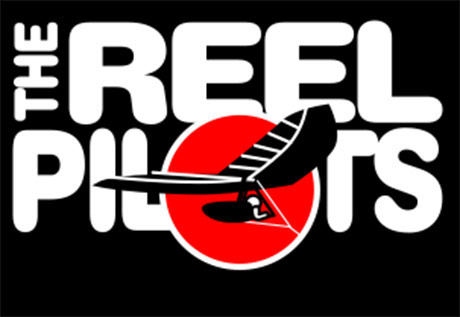

![]()
by Peter Birren, member of The Manbirds HG Demonstration Team
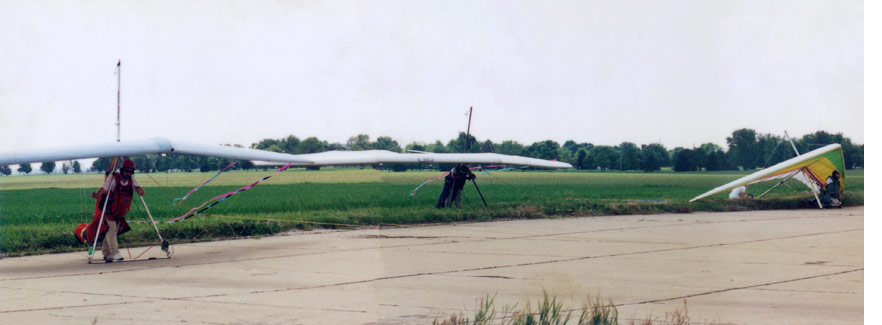 Manbirds at the ready for a 3-abreast static tow launch at Rantoul. Gliders are decked out with streamers and smoke canisters. Three separate cars are on the runway waiting for the Launch Director to get the GO signal from the Airboss.
Manbirds at the ready for a 3-abreast static tow launch at Rantoul. Gliders are decked out with streamers and smoke canisters. Three separate cars are on the runway waiting for the Launch Director to get the GO signal from the Airboss.
Pilots (L-R) Peter Birren, Greg Fischer, Dan Hartowicz. Photo by Janet Hartowicz.
In August 2001, we did our 27th airshow as a team at the Rantoul IL Airport. This general aviation airport has been open to hang gliding since 1994 and we were on excellent terms with the management of the field. They literally bent over backwards to help us and we, in turn, provided site insurance, used an aircraft transceiver for positive communications to the radio-equipped HG pilots, and performed in their annual airshow. Here are some of the things we learned doing these shows as well as experience from other pilots.
Participating in an airshow can be a lot of fun... if you're prepared. There are several ways you can be involved at different types of shows. There can be no better way of watching a show, nor there can be any faster way of wearing out your your welcome with the airport, air boss or airshow management group. Good preparation and understanding the whole airshow attitude are the keys.
![]()
ATTITUDE
Before you can begin considering performing or demonstrating in a show, even a small one, you should know about the "culture" of airports and pilots, and how we as hang glider pilots relate.
First, the airplane owners and airport managers think of us as bums. That may seem harsh and unfair, but consider just the difference in costs of our aircraft. Then consider the amount of time and money they have all spent earning even the most basic license. Then consider the differences in speed, risk, etc., between our types of craft. Then add in the number of flying hours they log in a year compared to what little we get thermalling. When you add it all up, they may think what we do is cool, but it can't compare (in their minds) with their megabucks, fuel-guzzling, cloud-drilling transportation machines.
Second is the airport property. Just the land is worth many millions, then add all the hangars, lights, avionics, etc., and it comes to a sizable investment... and we don't even, at the very least, buy aviation fuel to help support their business.
Third, with payout or static line towing we use long lines that very really could present a "hazard to aviation." (Aerotowing is a different subject all together.) Frankly, our towlines can bring down an airplane and kill all aboard.
These three main topics mean you MUST be on your best behavior at all times. You must always consider it a privilege and an honor to be permitted onto the field and respectful of all the facilities and people who use it. Our end goal was to earn enough money to buy our own tow site (can you say "Rose colored glasses"?). We needed to know the inner workings of an airport so more sites in and around the Chicago area could be opened to flying. We did make a few bucks, enough to pay for gas, registration in PAPPA*, and buy uniform shirts and jackets. We never came close to affording that country acreage.
*Professional Airshow Performers and Promoters Association
![]()
WHO DO I CONTACT?
This will be your first hurdle, finding the right person with the right authority to say it's OK for you to be there. Sometimes that person is the Airport Manager, often it's a highly experienced, hired "air boss" who is in charge of the show.
Before the Manbirds did their first airshow (1988), we contacted an Airshow Coordinator/ Organizer. He and others like him are members of ICAS (International Council of Air Shows). We talked at great length about our desire to perform and invited him out for a day at a regular site. He spent a lot of time with us and gave us some constructive criticism that we all took to heart and follow to this day.
![]()
WHAT TYPES OF DISPLAYS ARE ALLOWED?
This part will not try to tell you about the type of people you want to attract, but suffice to say that you want to educate the public and attract those with a dream of flight.
– Static Display –
This might be your first entry onto this field. How you behave and dress can influence the powers that be. The amount of interest you generate can also have a bearing on whether you may or may not have a future with the airport.
The priority here is to show-and-tell to the public, so having a setup glider and literature/ buttons etc. to hand out is important. Literature can be from your flying school and brochures/ magazines from USHPA. Having more than enough is better than running out and having another day to go. Work with USHPA and the Show Organizer to determine your needs.
The glider can be show-only, you can allow people to hang in the harness, or you can arrange for or build a simulator (call USHPA). Someone who has experience in such matters suggested that adults only be allowed in the harness as it eases your workload and provides for more intelligent discussion. Letting kids swing in the harness makes it a type of carnival ride and the adults will shy away.
There are several ways of setting up, and it's my opinion that indoors is best for some obvious reasons. Outdoors can be a good or bad thing if there's a light rain. You've got a big umbrella and it will attract all sorts of people until the rain stops.
– Flying Display –
How do you get to Carnegie Hall? Practice. Practice. Practice. This goes for an airshow performance as well. Three things are paramount to the airshow coordinator: Safety, Timing and Professionalism. In order for anyone to fly in a show, you MUST attend each morning's pilot briefing. This is a great opportunity to meet and interact with the other pilots, the organizers and the FAA. You'll get a full weather update for the day and be allowed to inform the show personnel of any particular needs you may have (but if your request is too weird, you could be scrubbed).
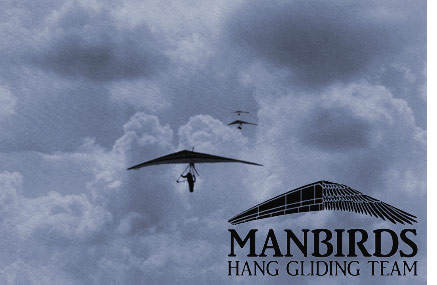
When multiple static tow launches are orchestrated properly, they're a thing of beauty... not only to watch but also to participate in. From a pilot's perspective, there's the challenge of formation flying and being the center of attention, pulling off precision landings in front of a crowd of thousands. For the launch crew, especially the Launch Director, there is a very real excitement in getting everyone off safely.
![]()
The first rule of airshows: "No one gets hurt."
The second rule: "See rule #1."
This means knowing and practicing all the parts of FAR103, like never flying over the crowd. There will be FAA guy(s) there watching your every move during the show and they can influence the airport manager either way.
If it's your desire to use the airport as a flying site, this can be critical. So watch what you say to everyone at all times. Don't talk bad about the show or the people. You never know who's listening. Always have something good to say.
![]()
TIMING
... means that you'll have a specific performance "window" that you must not exceed, even if it means cutting your act short. Let's say that you have a 15-minute window from 11:30-11:45am; not exceeding that time allotment means all gliders MUST be on the ground on or before 11:45. NO EXCEPTIONS! A good aid in keeping time is having one of your support crew on the ground with a radio to give you a time warning of 1-3 minutes. Thermalling is fun, but that's not why you're there.
![]()
PROFESSIONALISM
... is looking and acting the part at all times. It also means cooperation with everyone in charge. Looking the part could be as simple as having everyone in identical T-shirts (or better), clean pants, etc., and no drinking anything harder than Pepsi during the show by any of the crew.
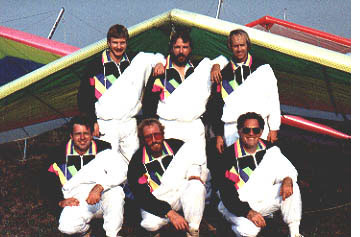
The Manbirds' first team promotional photo from 1990. Color prints were sent to the various airshow publications and the promoters for use in the show's program and newspapers. These flight suits were returned the next day when they proved to be way too hot and uncomfortable. We settled on silk-screened white sport shirts, khaki pants and screened teal jackets. Pilots (L-R front) Chris deLannoy, Dan Hartowicz, Brandt Snyder. (Rear): Greg Fischer, Peter Birren, Dave Whedon. Photo by Bill Bryden.
Do I have to say anything about acting the part? I don't think so... if you want to be invited back.
If you're at an airport, then you'll be towing, so a crew is necessary. They should be instructed to always look and act the part as well.
Another part of professionalism is having something prepared for the hired announcer to broadcast over the public address system or providing your own "voice." You should have a tape or a script to give the announcer at the pilot briefing, complete with cues to start and stop. A spoken script for the announcer should be in a couple of parts: the main part is pilot names, glider colors and basic information about your act; then add in "filler" copy that the announcer can use if there's time, stuff like where the school or main flying site is located, etc. Then add "fluff" like the quote from Leonardo daVinci or Lilienthal.
![]()
CAN I DO A SOLO PERFORMANCE?
One glider in the air is better than no glider, so a solo act is OK. The announcer can even read copy into the radio and you follow his cues, or you can do it freeform. Land perfectly in a pre-designated spot or close to show center. Showboating is permitted (it is a show, after all), like bicycle pedaling your feet when upright and ready to land (gives everyone a good laugh). If you have enough radio gear, it's pretty cool to do your own announcing from the glider, but this takes a good voice and lots of practice.
![]()
WHAT IF A FEW OTHER PILOTS WANT TO ATTEND?
The more the merrier, right? Not so unless you've all practiced as a team. For multiple glider acts a Launch Director is an absolute must. This person will direct all tow vehicles and pilot launch sequences. If you think you can do without this job, then you're trying to fool yourself. The LD is the time keeper, main radio person, setup coordinator, briefing attendant, ruffled-feather-smoother, etc. S/he may even be your best pilot, but is certainly the one who "knows it all" and can be flexible enough to take problems in stride, and one that the pilots and crew will listen to and obey. Without an LD you'll make the Keystone Cops look like a drama group. (Hmmm, wonder how I know?)
![]()
CAN I GET PAID?
Generally, no. The only ones allowed by the FAA to be paid for flying are those who hold a Commercial Pilot's License. Getting reimbursed for travel expenses is permitted, though sometimes it's like pulling teeth. And other times, asking for money is a surefire way of not being included in the show. However, if you are a Dan Buchanan and are a member of PAPPA or ICAS, then you're already in the game and know the other rules.
– Professionals –
The main airshow performers usually don't make their total living on the show circuit, though some do make pretty good money. They've got the experience and uniqueness that make them a wanted commodity. These are teams like The Red Baron Squadron, Lima-Lima, or the 2-plane French Connection. Single plane acts like Gene and Cheryl Littlefield who do a day or night wingwalking act, and Manfred Radius who does a day or night sailplane performance where he does an inverted ribbon cut (fabulous to see!) have honed their flying skills and travel around the country to lots of shows every year.
Unless you're prepared to do all the years of hard work needed to be a true pro, then you're most likely in it to just impress the airport people that you can conduct yourselves responsibly. So don't kid yourself that you're a valuable asset to the show, because they don't care one bit about what we do... hang gliding is pond scum in the eyes of much of General Aviation and they'd probably rather not have us mucking up their show.
– Getting paid – getting screwed –
If you do make arrangements to get paid, make sure you collect. Be prepared to be offered half of what was agreed upon. They will give you "reasons" like the attendance was less that expected, it rained, insurance costs were higher, etc. You may even get stiffed completely. If you do get to collect, then you know more of the game and probably could write this primer yourself. If you're doing the show for free, you might be able to get some passes for friends and relatives or students, but don't overdo your request (enough for maybe 10 should do, including one for each member of your team). It's also possible to get invited to pilot parties, usually only after you've attended several shows and get to know some of the characters involved.
![]()
WHAT OTHER KIND OF PREPARATION DO I NEED TO DO?
– Before the show –
Practice your act and know what you can do in different length windows. Work on your landings. Perfect your towing equipment. Get a wardrobe that will only be used for the shows. Same goes for doing a demo flight for an airport manager and his cohorts.
Write or call USHPA for support a month or two before the show. Get brochures and business cards printed. Make sure your display and information are flawless. Arrange (kidnap?) others into helping so you'll have time to eat or answer nature's call.
Learn the layout of the airport, where you'll launch from in all directions of wind, where the LZ is, where the towline will drop (NOT on the crowd), etc. Have contingency plans for Worst Case Scenarios, because they will happen.
Prepare a press release, complete with black and white photos of you and/or your team. Make several copies. Send copies to the airshow coordinator and to the local press about 3-4 weeks prior to the show date. Type it cleanly, double-spaced and include personal information as well as class availability, local and world records, how long you've been flying, and other similar stuff. This will likely get in the show program and in each day's local newspaper.
Invite a local TV station to come out for an interview at an active site.
– During the show –
Arrive early. Offer to help. Be early for the pilot briefing (one person minimum necessary). Set up out of the way. Know your window. Be ready to go when the window opens and be on the ground when or before it's closed. Keep your static display area neat and clean. Be friendly. Answer every and all stupid question. Smile a lot. NO BEER or other alcoholics.
– After the show –
Park your glider so it doesn't block the crowd's view of the rest of the show. Make yourself available for autographs, maybe one of your crew has a convertible that the pilots can ride in down the crowd line (smile and wave a lot). Follow up with the airshow organizer and the airport manager (and/or other appropriate people) to get feedback on your group/performance. Send a thank you note to the main folks. Follow-up with your new student-hopefuls.
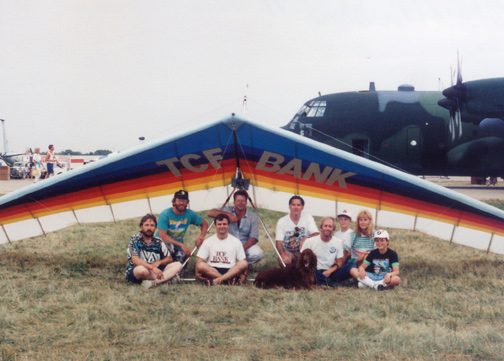
The Manbirds first show in 1991 at the Rockford IL Airport. Got to hob-nob with the Blue Angels pilots!
We were sponsored in several airshows which made on-site behavior that much more important.
![]()
WHAT'S NEXT?
If the show was a good experience for all, make it known that you want to be included in next year's event. Ask for objective opinions on your performance. Involve the people in charge so they know you're serious and are open to their suggestions (even if you aren't). If it's your desire to have the field as a site, a week or so after the show is a good time to try arranging a private demo flight. If you do get permission to fly at the site, make sure every person in your party has the same respect for the site and its protocols as you do. See HERE for advice in opening an airport for flying.
![]()
Bill is the former Regional Director for USHPA Region 7. This email from Bill adds a lot to the list of considerations.
Did the Airport Manager ask about a yellow flashing light or orange check flag, etc. for vehicles on the runway? Hopefully we won't need that stuff but airshows sometimes want it, not that it makes any safety difference (it just looks official and all that).
Does T has the simulator and some buttons and pamphlets?
I just got 10,000 feet of new tow line so I'll put a new line on the reel and hopefully test it to 300 pounds before Saturday. If not, we'll have to do a quick test pull Saturday before we use it.
A few points for all to remember. (I think I'm preaching to the choir but just as a reminder for all)
• In doing HG at an airshow etc., it is to show the public how neat the sport is. That is it! Period. If you are wanting to stroke an ego with the attention or feel important or anything else, stay on the ground or even at home.
- No whacks. If there is one whack with a dozen or more flights, we maybe break even in the public's perception of the sport. If there are anymore than that, the sport loses. Just ONE whack with only a few flights and we lose in the PR arena. The public thinks that hang gliding is a dare devil dangerous sport and ANYTHING that looks abrupt, remotely pounding, sort of dangerous (even if not) etc., reinforces that notion. EVERYTHING must look smooth, gentle, enjoyable and organized. There have been other airshow performances I've heard about (in far too much detail by some irritated pilots) with multiple whacks, people breaking tow lines repeatedly, stuff being dropped, new equipment being used for the first time that failed, and folks that can't land on the LZ and ended up in crops. Those performances caused much far more harm for the sport of hang gliding than help. We will not be doing that nonsense.
• Gliders: It is fine to have double surface gliders on display etc. but ONLY simple, easy to fly and land in tailwind gliders should be flown. Targets, Funs, Falcons and similar are the ONLY type of gliders that should be flown. This is to maximize the potential for achieving the point above. Higher performance gliders should not be flown. The public does not know the difference and won't give a rat's ass that its the latest XYZ fancy ship. A nice gentle one or two step landing EVERY time will be far more impressive.
• Aerobatics: There is no need for these. The public will be suitably impressed just watching a smooth gentle flight with no extreme attributes. We want them to walk away thinking, "Wow, that looked so cool and easy and safe. I think I might like to try that." Wingovers, spins, etc. MIGHT instill a "I didn't know they could do that" response in some folks but most will think "Wow, that's extreme and not for me!" and few will be prompted to want to fly. We'll be in controlled airspace probably without an airshow waiver, and even though FAR part 91.303 (which prohibits aerobatic flight in controlled airspace, below 1500 ft. etc.) doesn't technically apply to Part 103 vehicles, we'll likely still be expected to comply with those provisions as all the other aircraft at this event will have to do.
• Winds and weather. If you don't have 100% confidence that a good launch, tow, flight and landing are certain, don't fly. Each good flight might earn 1 or 2 PR points with the spectators but an accident will earn a few hundred or thousand negative PR points (a few million negative PR points if someone shoots a good video of the event and it gets into the media). So there is lots to lose and only small points to gain and you must be 100% certain not to lose.
• Have fun. It is contagious. (Don't be too "wild" though)
![]()
From Bev and Gord Moog on the Long Beach CA show
It was nonstop visitors, questions, demonstrations and hand outs from 8:30 'til 3:00 pm. All of us had packed drinks to drink, lawn chairs to sit on and books to read, but no one had a chance to drink, sit or read! Sunday was the same, beginning a half hour earlier. The crowds arrived at 9:00 am and we worked solid through 3:30 pm.
We distributed over 300 complete PR kits and, running out of the different pieces, another 200 partials. Each (complete) kit had both HG and PG materials in it, including the national magazines as well as ads for hang gliders and paragliders and fliers from several area schools. Lessons Learned...
Here's what we've learned from our
combined experience in two shows:
• The rest of the aviation community considers "us" one of "them". This is good, and we in the HG & PG community should capitalize on it.
• The public is aware of hang gliders and paragliders and have plenty of intelligent questions about them.
• Everyone had to touch the gliders. Invariably they'd walk up & caress the leading edge, then drag a couple of fingers across the sail.
• They love demonstrations:
(1) demonstrations of both the HG and PG harnesses,
(2) HG variable geometry,
(3) ground handling and towing PGs.
• It worked best to have all the handouts prepackaged together so the whole batch could be given to the spectator.
• Having the chase vehicle at the back of the set up was critical. Logistically it's a warehouse, work bench and secure storage facility. Also, folks do have questions about "how big is the glider when you disassemble it", how do you carry it to launch, and when you go cross-country how do you get home? A glider in the bag or tube on top of the rack made the answers easy.
• The following were the most frequently asked questions:
Q. Where are the local flying sites?
Q. How do you take off and land?
Q. Where can I get lessons, what do they cost, and how long does it take to learn?
Q. What does a glider cost?
Q. Are there places to fly in Mexico?
There were several things which would/could have made the display better, easier & more effective:
• We could have used twice the number of HG & PG buttons (the kids loved them) and four to five hundred complete PR kits would have been about right.
• An HG simulator would have been a great hit, again particularly with the kids. The PG harnesses on the rack were very popular.
• A map showing the major flying sites, clubs and schools would have very helpful.
• A handout especially for kids, consisting of a line drawing of a hang glider and a paraglider, for them to color with crayons at home would probably have been worth the effort. A scanned or drawn image could be generated and printed for nothing more that the cost of the paper and a bit of time.
• Even with the additional help this year, we still couldn't keep up. Ideally, each participant should be relieved periodically to visit other displays, get a bite to eat and even get to the head.
Conclusions: We continue to think there's lots of opportunities to "spread the word" about hang gliding. Even if everyone isn't going to run out and take lessons, if they have a chance to see our equipment, ask questions and talk to us, it might help the public's perception of the sport. "Planting the seeds" with the kids of today could result in gains for the sport in the future.
Other pilots have attended shows or participated in them. Seek their wisdom. Wear comfortable shoes.
Good luck!
![]()
DISCLAIMER: As with all aviation endeavors, your choice and use of equipment is totally up to you. It is assumed you are an experienced HG or PG tow pilot who is intimately familiar with the style of towing you will be doing. As such, YOU ASSUME ALL RISK AND LIABILITY in the use of the Linknife, as well as all other parts, functions and personnel involved in the towing and flight operations. If you do not have experience in towing, please contact an instructor for expert training. Trying to learn on your own can, and probably will, result in your injury and even death. Many pilots have paid the ultimate price so we may now tow as safely as never before possible. Please learn from their lessons.
Linknife Home | Static Line | Payout/Platform | Aerotow | Testimonials
Reel Pilots Home |
Hewett's Towing Criteria |
Driver SOP
Static Line Basics |
Static Towing Parts |
Hewett Bridle Basics
Parachutes |
Lockouts |
Payout Primer |
Flying Sites
Links clubs/info |
Links2 states/countries
Airshow |
Site Opening Primer
Birren Design Company | Site Map
©2000-2023 Peter Birren email
Powered by w3.css